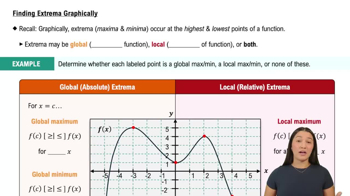Table of contents
- 0. Functions7h 52m
- Introduction to Functions16m
- Piecewise Functions10m
- Properties of Functions9m
- Common Functions1h 8m
- Transformations5m
- Combining Functions27m
- Exponent rules32m
- Exponential Functions28m
- Logarithmic Functions24m
- Properties of Logarithms34m
- Exponential & Logarithmic Equations35m
- Introduction to Trigonometric Functions38m
- Graphs of Trigonometric Functions44m
- Trigonometric Identities47m
- Inverse Trigonometric Functions48m
- 1. Limits and Continuity2h 2m
- 2. Intro to Derivatives1h 33m
- 3. Techniques of Differentiation3h 18m
- 4. Applications of Derivatives2h 38m
- 5. Graphical Applications of Derivatives6h 2m
- 6. Derivatives of Inverse, Exponential, & Logarithmic Functions2h 37m
- 7. Antiderivatives & Indefinite Integrals1h 26m
- 8. Definite Integrals4h 44m
- 9. Graphical Applications of Integrals2h 27m
- 10. Physics Applications of Integrals 2h 22m
5. Graphical Applications of Derivatives
Intro to Extrema
Problem 3.6.58d
Textbook Question
{Use of Tech} Flow from a tank A cylindrical tank is full at time t=0 when a valve in the bottom of the tank is opened. By Torricelli’s law, the volume of water in the tank after t hours is V=100(200−t)², measured in cubic meters.
d. At what time is the magnitude of the flow rate a minimum? A maximum?
 Verified step by step guidance
Verified step by step guidance1
First, understand that the flow rate is the derivative of the volume with respect to time. So, we need to find the derivative of V with respect to t, which is V(t) = 100(200-t)^2.
Apply the chain rule to differentiate V(t) = 100(200-t)^2. Let u = 200-t, then V(t) = 100u^2. The derivative of V with respect to t is dV/dt = 100 * 2u * (-1) = -200u.
Substitute back u = 200-t into the derivative to get dV/dt = -200(200-t). This represents the flow rate of water from the tank.
To find when the flow rate is a minimum or maximum, we need to analyze the critical points of dV/dt. Set the derivative of dV/dt with respect to t equal to zero and solve for t.
Since dV/dt = -200(200-t), the derivative is constant and does not have any critical points. Therefore, the flow rate is maximum at t=0 and decreases linearly over time, reaching a minimum when the tank is empty.
 Verified video answer for a similar problem:
Verified video answer for a similar problem:This video solution was recommended by our tutors as helpful for the problem above
Video duration:
2mPlay a video:
Was this helpful?
Key Concepts
Here are the essential concepts you must grasp in order to answer the question correctly.
Torricelli's Law
Torricelli's Law describes the speed of fluid flowing out of an orifice under the influence of gravity. It states that the speed of efflux is proportional to the square root of the height of the fluid above the opening. This principle is crucial for understanding how the volume of water in the tank changes over time, as it directly relates to the flow rate and the volume function provided.
Flow Rate
The flow rate is the volume of fluid that passes through a given surface per unit time. In this context, it can be determined by taking the derivative of the volume function V(t) with respect to time t. Analyzing the flow rate helps identify when it reaches its minimum and maximum values, which is essential for solving the problem posed.
Recommended video:

Intro To Related Rates
Critical Points
Critical points occur where the derivative of a function is zero or undefined, indicating potential local maxima or minima. To find the times when the flow rate is at a minimum or maximum, one must calculate the derivative of the flow rate function and solve for these critical points. This analysis is fundamental in determining the behavior of the flow rate over time.
Recommended video:

Critical Points

 5:58m
5:58mWatch next
Master Finding Extrema Graphically with a bite sized video explanation from Callie
Start learning





